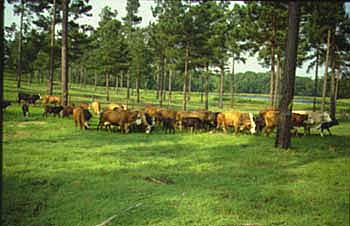What is it?
Silvopasture is the intentional combination of trees, forage plants and livestock together as an integrated, intensively-managed system. Silvopasture can provide profitable opportunities for softwood or hardwood timber growers, forest landowners, and livestock producers.
Benefits: Silvopasture has several advantages over timber or pasture alone
Return on investment. By adding a livestock production component, silvopasture creates a stable source of cash flow prior to nut or timber harvest (e.g. pine, poplar or pecan) and diversifies the forestry enterprise. For livestock graziers, add a long-term timber while maintaining forage production provides more income than grazing alone. In some areas, pine straw harvest can also provide supplemental income.
Silvicultural benefits. Nitrogen-fixing forage species, pasture fertilization and animal manure all help improve the soil and tree nutrition. Grazing controls competing brushy species and reduces fire hazard. Competition between trees is less at the wider spacings employed with silvopasture. The result is greater timber yield.
Livestock benefits. Trees create a sheltered microclimate to protect animals from heat and cold. Shelter also improves forage quality and lengthens its growing season. The prunings of some trees can also be used as fodder, e.g. poplar. The result is better livestock growth.
Wildlife. By creating a more biologically diverse system, wildlife habitat is also created.
Small Farms: Add trees to pasture
Softwood trees are planted on existing pastures or range in widely-spaced single or double rows. This arrangement reduces shading and root competition while maintaining forage production over a longer portion of the timber rotation.
Combine nut trees with grazing
Legumes grown in the alleys between nut trees such as pecans and black walnut can provide high quality forage for livestock. Grazing can be used instead or in addition to mowing to manage the orchard floor to reduce erosion and improve wet-weather trafficability. Trees should be at least 10-12 feet tall before grazing starts. Some pesticides used in nut orchards may restrict grazing following application.
Forest and Woodland: Add a grazing enterprise
In native or planted forests, forage species can be sown under an existing tree plantation that has been thinned and pruned, and cattle or sheep introduced under a managed, rotational grazing system.
Silvopasture succeeds when management practices for the trees, forage and livestock are compatible:
Tree component. Choice of tree species is determined by the soil and climate of the site, as well as potential markets for wood products. Conifers are generally better suited than hardwoods to silvopastoral systems, but grazing is successful in pecan orchards. Spot or strip spraying around the trees during the first few years after planting will reduce competition from forage grasses and improve tree growth. Periodic thinning and pruning of the trees are important not only to improving wood quality, but also to providing more light for forage growth.
Forage component. A variety of perennial warm or cool season grasses and legumes can be used in silvopastures. They tolerate shade and avoid competitio with the trees by growing in different seasons or rooting at different depths. Simple grass / legume mixes can be over-seeded with other species to extend the grazing period. By designing tree row spacing to accommodate haying equipment, forage can be mechanically harvested until the trees are tall enough not to be harmed by some livestock browsing or rubbing.
Livestock component. Cattle and sheep are the most common animals used in silvopasture, although other species also have potential. Although cattle can more easily trample young trees or compact wet soils compared to sheep, they may be less likely to browse trees. Careful observation of herd behavior is necessary to detect and correct potential problems with browsing or rubbing of trees. Electric fencing or individual tree guards may be necessary to protect trees if animals are introduced when they are still small. Fencing is also used in rotational grazing methods to better control forage consumption.


